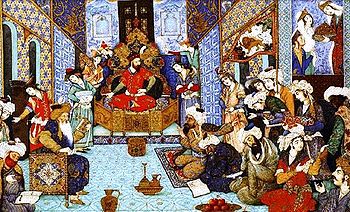At the period of the first Muslim conquests, Lahore was in possession of aChauhan prince, of the family of Ajmer. Whether owing to change of dynasty, or to Lahore's exposed position on the high road fromAfghanistan to India, it was subsequently deserted and the seat of the government was removed to Sialkot or its vicinity, where it remained until the period of the conquests of Sultan Mahmud Ghaznavi in the beginning of the eleventh century; that the conqueror re-occupied the deserted city, and established a garrison in a fort, which was built possibly, like the Old Fort at Delhi, on the ruin of the old Rajput stronghold.
In 682 AD, according to Ferishta, the Afghans of Kerman and Peshawar, who had, even at that early period, embraced the Islam, wrested certain possessions from the Hindu prince. A war ensued, and in the space seventy battles were fought with varied success, until the Afghans, having formed an alliance with the Ghakkars, a wild tribe inhabiting the Salt Range of Punjab, compelled the Raja to cede a portion of his territory. The next mention of Lahore is in the Rajputana chronicles, where the Bussasof Lahore, a Rajput tribe, are mentioned as rallying to the defence ofChittore, when besieged by Muslim forces in the beginning of the ninth century.
At length, in 975 AD,Sultan Sabuktigin, Governor of Khorassan and father of the celebrated Sultan Mahmud Ghaznavi advanced beyond the Indus. He was met by Raja Jayapala, the Raja of Lahore whose dominion is said to have extended from Sirhind to Laghman and from Kashmir to Multan. By the advise of theBhati tribe, the Raja Jayapala formed an alliance with the Afghans, and, with their aid, was enabled to withstand the first invasion. However, Sabuktigin later repeated his conquest on his succession to the throne ofGhazni. A battle ensued in the vicinity of Lamghan ending with the defeat of the Raja and overtures being made for peace. His terms were accepted and persons were sent, on the part of Sabuktigin, to take the balance of the stipulated ransom. On reaching Lahore, Jayapala proved faithless and imprisoned those commissioned to receive the treasure. On learning intelligence of his perfidy, Sabuktigin, in the words of the Ferishta, "like a foaming torrent, hastened towards Hindustan".[7]
Another battles ensued, in which Jaipal was again vanquished, and he retreated, leaving the territory to the west of the Nilab or Indus in the hands of the invader. The invader did not retain the conquests that he had made for in 1008 AD, a confederation headed by Anandapala, the son ofRaja Jayapala, again met the advancing army, now commanded by Mahmud, son and successor of Sabaktagin, in the vicinity of Peshawar. Lahore was allowed to remain intact for thirteen years longer. Anangpal was succeeded by Nardjanpal, while Mahmud pushed his conquests into Hindustan. But in 1022 AD, he suddenly marched down from Kashmir, seized Lahore without opposition, and gave it over to be plundered.[8]Nardjanpal fled helpless to Ajmer, and the Hindu principality of Lahore was extinguished forever. A final effort was made by the Hindus in the reign of Modud, 1045 AD, to recover their lost sovereignty, but after a fruitless siege of six months, they retired without success.[9]
Few references to Lahore exist for times before its capture by Sultan Mahmud Ghaznavi in the eleventh century. In 1021,Mahmud appointed Malik Ayaz to the throne and made Lahore the capital of the Ghaznavid Empire.
The Sultan Mahmud Ghaznavi took Lahoreafter a long siege and battle in which the city was torched and depopulated. As the first Muslim ruler of Lahore, Ayaz rebuilt and repopulated the city. The present Lahore Fort stands in the same location. Under his rule, the city became a cultural and academic center, renowned for poetry. The tomb of Malik Ayaz can still be seen in the Rang Mahal commercial area of town.
After the fall of the Ghaznavid Empire, Lahore was ruled by various Muslim dynasties known as the Delhi Sultanate, including the Khiljis, Tughlaqs,Sayyid, Lodhis and Suris.[10] When Sultan Qutb-ud-din Aybak was crowned here in 1206, he became the first Muslim Sultan of South Asia.[11] It was not until 1524 that Lahore became part of the Mughal Empire.



No comments:
Post a Comment